|
from 14 april 2002 blue vol II, #29 |
|
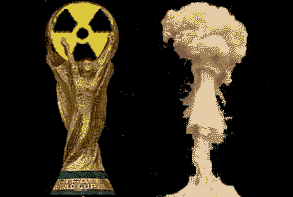
World Cup Matches Near Nuclear Accident Site Armed British ship sails to Japan to retrieve rejected MOX
by Eanna Dowling
The Japanese Nuclear Agency rated the incident as Level Four. Level four on the International Atomic Energy Agency's zero-to-seven International Nuclear Event Scale indicates the possibility of a fatal radiation leak at the accident site but no significant risk outside the plant. The Chernobyl accident in 1986, rated a level seven, was the worst nuclear power accident on record.
Following the publication of the official report, almost a year after the accident, police in Japan arrested six officials from the nuclear fuel processing plant. They charged the officials with "professional negligence" in connection with the accident. The report found a lack of safety culture led to the incident. The Nuclear Safety Commission apologized to the Japanese cabinet for not doing more to prevent the accident and promised to do better.
The Tokaimura site has a range of nuclear facilities, including a plutonium reprocessing plant that suffered a fire and explosion in April 1997, which at the time was Japan's most serious accident. The operators of the plant are currently considering reopening the plant later this year, despite having no need for any more plutonium. Japan currently has a stockpile of over 5 tonnes of plutonium in Japan, with a further 30 tonnes in Europe, awaiting to be shipped to Japan.
The leader of the main opposition party in Japan has gone on the record calling for Japan to develop an independent nuclear weapons capability. Ichiro Ozawa stated on April 6th that Japan could use its plutonium stocks to make thousands of nuclear weapons. At the moment, the US who have occupied Japan since World War II, hold nuclear weapons at their bases. Recently the Japanese Diet (parliament) passed the first phase of a series of legislative measures that will permit the deployment of the Japanese defense forces abroad. Part of the surrender agreement following the second World War prevented Japanese troops from ever engaging in conflict overseas. In addition, Japan is the technological partner of the US's "star wars" program. Initial testing on "star wars" takes place on Japanese islands.
Tokaimura is also, like most of Japan, in an area of high seismic activity. On July 21st 2001, an earthquake measuring 6 on the Richter scale was recorded under the sea off the coast of Ibaraki. Since 1926, 13 earthquakes of that magnitude or higher have been recorder within 30 kilometers of the July 21st event.
The September 1999 incident at Tokaimura came less than 24 hours before the arrival of a shipment of weapons-usable plutonium at the Takahama nuclear power plant in Fukui Prefecture. That plutonium shipment was the center of a scandal due to the producers of the fuel, British Nuclear Fuels (BNFL), having admitted to falsifying important safety data during production. Later that year, mixed uranium plutonium oxide (MOX) fuel shipped to Japan from British Nuclear Fuels (BNFL) was found to be tainted because quality assurance data had been falsified. Following the scandal the chairman and other directors of BNFL were dismissed.
At the moment, just before the 2002 World Cup Finals, a heavily armed nuclear transport ship is on its way from Britain to Japan. It's mission is to retrieve the MOX fuel for the Takahama reactor, rejected by the Japanese nuclear industry in 1999.
The ship, the British flagged Pacific Pintail, recently passed through the Panama Canal. It is expected to arrive in Japan during the course of the World Cup. The loading of the MOX waste (containing 255 kilograms of weapons-usable plutonium, enough for 50 nuclear weapons ) may occur during the tournament.
Although the ship's route is officially secret, it may pass close by Niigata, where two first round matches - Ireland v Cameroon on June 1st and Croatia v Mexico on June 3rd - will be played.
On 17 April 2002 Greenpeace warned FIFA and the Japanese organizing committee (JAWOC) about the increased security risk due to the arrival of the ship during the World Cup. Protection of the vessel from terrorist attack would divert security resources from the tournament. In the aftermath of September 11th, security at the World Cup will be at an all time high.
The campaign to close Sellafield is something of a national pastime in Ireland. U2 have had their photos taken in radiation suits on a nearby beach. Bono's wife Ali Hewson delivered a postcard to Tony Blair at 10 Downing Street earlier this year calling for the site to be closed. The card was one of a million reportedly sent to Blair, BNFL and Prince Charles. In addition Irish Governing political party Fianna Fail, took out a full page ad in the London Times calling for the closure of Sellafield. It appears unlikely that they will repeat the ad in the Japan Times calling for the closure of Tokaimura. However the campaign does not extend to the Irish Government opposing the EU's European Bank for Reconstruction and Development issuing loans to Belarus, the Ukraine and Georgia to construct new nuclear stations in Eastern Europe.
Few Irish fans going to cheer on their team in Ibaraki are aware of the links between the nearby nuclear complex and Sellafield. Yet the trade in nuclear waste goes in. Sellafield is one of only three nuclear waste reprocessing facilities and is unlikely to close until all nuclear power plants have been decommissioned.
German fans are Governed by a Social Democrat/Green coalition which has promised to phase out nuclear power by 2020. German activists have famously blocked trains carrying nuclear waste from traveling through populated areas. These trains carried waste bound for Sellafield.
The world's spotlight falls on Japan over the coming month of the World Cup. Will the shadow of Tokaimura streaks across the pitch at Ibaraki or will the fans revel in the contest and turn off the lights on the real world?
|
|||
|
BLUE is looking for short fiction, extracts of novels, poetry, lyrics,
polemics, opinions, eyewitness accounts, news, features, information and arts
in any form relating to eco cultural- social- spiritual issues, events and
activites (creative and political). Send to Newsdesk. |

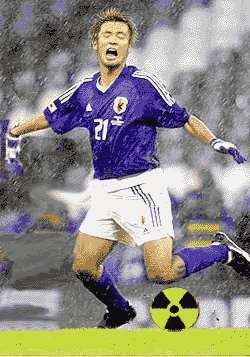 The nuclear accident occurred at a uranium processing plant at Tokaimura in Ibaraki Prefecture, about 90 miles northeast of Tokyo. Tokaimura has a population of around 34,000 people and is home to 15 nuclear-related facilities. Workers put nearly eight times the proper amount of condensed uranium into a mixing tank, triggering a nuclear chain reaction. The number of people who received some radiation exposure from the accident has been repeatedly revised upward; the latest official estimate has increased by 229 to 667.
The nuclear accident occurred at a uranium processing plant at Tokaimura in Ibaraki Prefecture, about 90 miles northeast of Tokyo. Tokaimura has a population of around 34,000 people and is home to 15 nuclear-related facilities. Workers put nearly eight times the proper amount of condensed uranium into a mixing tank, triggering a nuclear chain reaction. The number of people who received some radiation exposure from the accident has been repeatedly revised upward; the latest official estimate has increased by 229 to 667.
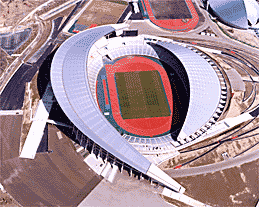 About one-third of Japan's electricity is supplied by 51 nuclear reactors, more than any other country except France with 58 reactors and the United States with 104. In the aftermath of the accident, Japanese power companies have scaled down to 13 from the 20 or so new reactors they had planned to build by 2010. But Japan remains committed to nuclear power. With few natural resources of its own, Japan imports nearly all its fuel oil. Since the oil crisis of 1973, successive governments have made concerted efforts to become self-sufficient. By the year 2010, Japan wants to produce 42% of its energy in nuclear plants.
About one-third of Japan's electricity is supplied by 51 nuclear reactors, more than any other country except France with 58 reactors and the United States with 104. In the aftermath of the accident, Japanese power companies have scaled down to 13 from the 20 or so new reactors they had planned to build by 2010. But Japan remains committed to nuclear power. With few natural resources of its own, Japan imports nearly all its fuel oil. Since the oil crisis of 1973, successive governments have made concerted efforts to become self-sufficient. By the year 2010, Japan wants to produce 42% of its energy in nuclear plants.
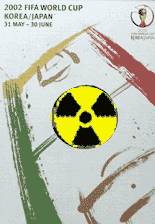 The 1999 BNFl MOX cargo came from Sellafield in North West England. This site has been particularly controversial in Ireland due to a belief that discharges and incidents at Sellafield are responsible for cancer clusters on the East coast of Ireland. After the September 11 attacks in the US, many Irish commentators raised fears about similar attacks on Sellafield.
The 1999 BNFl MOX cargo came from Sellafield in North West England. This site has been particularly controversial in Ireland due to a belief that discharges and incidents at Sellafield are responsible for cancer clusters on the East coast of Ireland. After the September 11 attacks in the US, many Irish commentators raised fears about similar attacks on Sellafield.
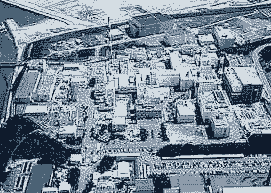 Nuclear Power Plant Accidents
Nuclear Power Plant Accidents